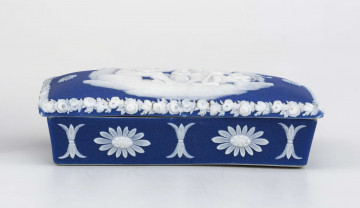
Casket
1801 — 1900
National Museum in Lublin
Part of the collection: English stoneware – Wedgwood
The founder of the manufactory, Josiah Wedgwood I, came from a family of potters and thus had a good understanding of its production process. He undertook a long-term project of improving the composition of the raw paste used to produce faience. It is to Wedgwood that we owe the development of earthenware in a characteristic cream colour whose tint changes depending on the quality of the ingredients used, the purity of the paste, and the proportion of fine-grained clay mixed with ground calcium silicate used in the production process. This new type of earthenware quickly gained popularity and for centuries has been a staple on the tables of aristocracy, royalty, and eminent personalities.
A testament to the popularity of Wedgwood's products is a series of letters exchanged by Samuel Shoemaker, an American traveller visiting London. Impressed by English ceramics, he bought a selection of wares and sent them to his wife in Pennsylvania. According to a letter dated 22 April 1784 received by Shoemaker, the package arrived in America in the spring, and “the kettle and creamer are some kind of a rare curiosity. I have to say that nothing of the sort has come our way before – they have actually mastered this production method to perfection! However, we felt that these little figures should be dressed […] if only they were wrapped in a thin veil, we could show them more freely in company without worrying that we would offend someone's modesty" (after: G. Blake Roberts, Josiah Wedgwood I – człowiek garncarz in: Wedgwood Ceramika XVII–XX wieku, Warszawa 2002, p. 29).
Wishing to keep his products in high demand, Wedgwood remained alert to any changes in fashion. And so, when the English society started to perceive the nudity of Greek characters depicted on earthenware as scandalous, the artist immediately "began to cover their pagan nakedness with robes and fig leaves" (ibid., p. 29).
Author / creator
Dimensions
cały obiekt: height: 5,8 cm, width: 13,5 cm
Object type
dish
Technique
ceramic technique
Creation time / dating
Creation / finding place
Owner
The National Museum in Lublin
Identification number
Location / status

1801 — 1900
National Museum in Lublin

2nd half of the 19th century
National Museum in Lublin

around 1700
National Museum in Lublin
DISCOVER this TOPIC
Museum of King Jan III's Palace at Wilanów
DISCOVER this PATH
Educational path